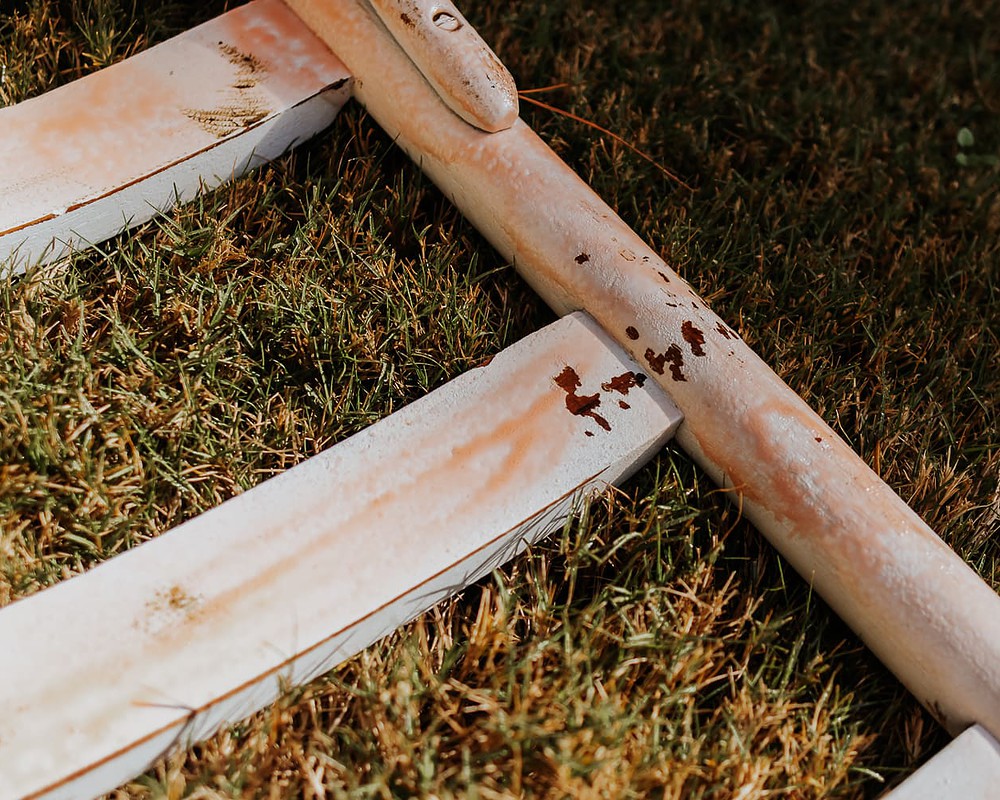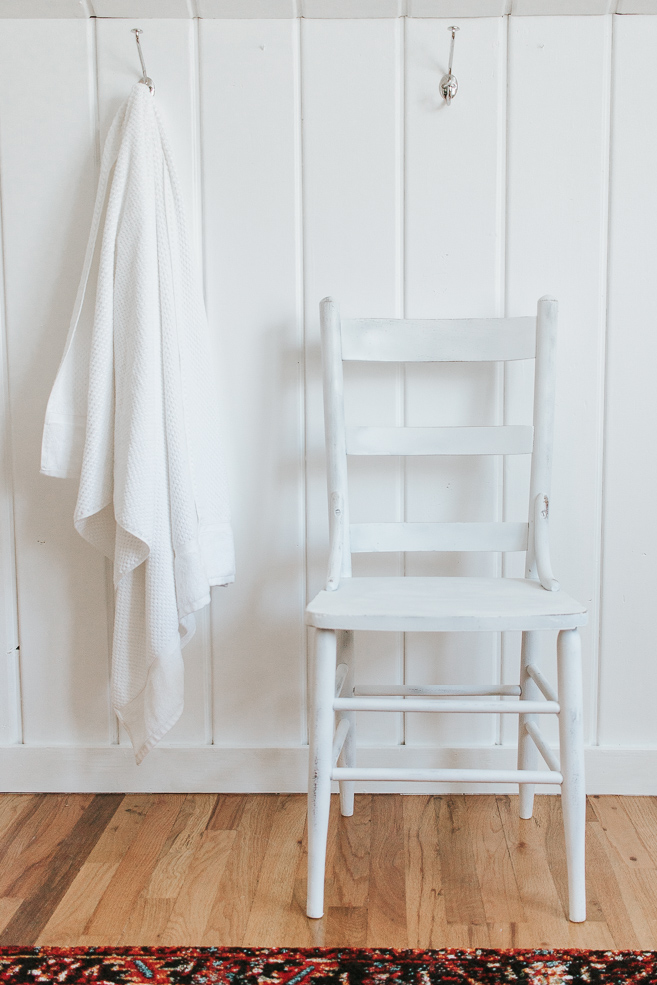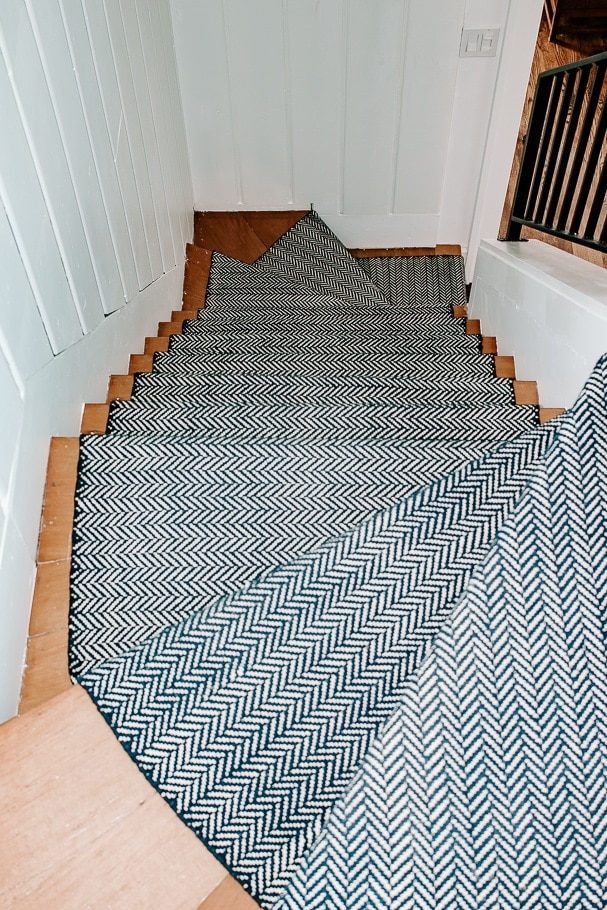How to Use Citristrip – My Best Tips

A step-by-step guide for how to use Citristrip and transform old furniture pieces into beautiful ones.
If you happened to score a great piece of furniture but have no idea how to take off the existing finish – this post is for you!
Today I’ll show you how to use Citristrip and transform that old piece of furniture into something beautiful and (almost) brand new!
I always use Citristrip because it’s low VOC and doesn’t contain methylene chloride which is dangerous to your health.
This is the same furniture stripping method I’ve used on several thrift-store finds and hand-me-downs and I thought it would be helpful to share my tips here. When I started – I had no idea what I was doing. Whether you are want to remove the old paint OR the old stain – this method will work.
Watch as I transform my grandfather’s old chair (which I previously chalk painted white) and an old thrift store wood stool.
Things You’ll Need when Stripping Furniture
- Citristrip Stripping Gel or Spray- If it’s a smaller piece like a wood stool I use the spray. If it’s larger – I use the larger gel bottle.
- Paint Brushes for applying the gel
- Steel Wool or Scour Pads or Bristle Brush(for intricate areas)
- Plastic Putty Knife for Scraping
- Paper Towels (for wiping putty knife off)
- Mineral Spirits or Paint Stripper After Wash and an old rag
- Sandpaper or Orbital Sander
- Chemical-Resistant Gloves and Mask and Safety GlassesDrop Cloth or old cardboard boxes
- Saran Wrap (optional)
- Lead Paint Test Kit (see note about Lead Paint)
A Quick Note about Lead Paint
Whenever you pick something up from an old flea market or thrift store, it’s important to think about potential lead paint exposure. Lead Paint is hazardous to your health and was used in paints made before the 1980s. While I do believe that stripping the paint is safer than sanding it and potentially breathing in harmful lead paint particles – I AM NOT AN EXPERT. If you have an old piece of furniture you want to strip down, it’s best to test it for lead paint using an inexpensive lead paint test kit. If it tests positive, you should consult with a paint professional in your area for how best to proceed.
What is Citristrip?
Citristrip is an all-purpose stripping gel that allows you to remove layers of paint (both oil and latex paint), enamel, varnish, shellac, epoxy, and more from wood, metal, and masonry surfaces (I’ve only ever used it on wood though).

It contains no methylene chloride and is non-caustic and biodegradable, according to the manufacturer. Although it claims to be OK for indoor use, I always use it outdoors in the grass on a plastic bag to be safe. The bottle claims to have a “pleasant citrus scent” but I’m not so sure about that – I wear a heavy-duty safety mask.
Important Things to Know about Citristrip
There are a few important things to remember about using Citristrip.
- For Citristrip to work – it has to stay WET. That means that once it dries, it’s not working to remove the finish anymore. You can use saran wrap to seal the furniture piece and help it stay wet. It’s best to stay nearby and monitor the Citristrip while using it. It’s not a “set it and forget it” type of thing.
- Be generous with application – I like to glob it on. This helps in two ways. It prevents it from drying out and it’s just more stripping power.
- This is messy. I don’t want to sugarcoat it – it’s a messy job. Make sure you wear gloves, a mask, and safety goggles. Citristrip has an orange citrus scent but it never hurts to wear a mask. You also want to protect your surfaces with a drop cloth or old cardboard. It will remove the finish from whatever it’s on and touching. I’ve seen foam brushes melt and workbenches stripped of their finishes by accident.
- Citristrip is meant to be left on for anywhere from 30 minutes to 24 hours. I typically find that 1-6 hours is sufficient but it’s always best to test a small area first before removing the whole application.
- Steel Wool is your friend. It’s hard for a plastic scraper to remove everything, and wood sometimes has this intricate details that are hard to get into. That’s where steel wool or non-scratch scour pads (or a toothbrush) will help you. You can dip some steel wool into the stripper and attack little areas as need be.
- You can repeat the process! Don’t be afraid to do another few coats of Citristrip if the first or second applications didn’t remove everything.
How to Use Citristrip Stripping Gel
1. Prepare your Surface
First things first – prepare yo’ self! Make sure your area is covered with drop cloth or old cardboard and put on your safety glasses and gloves. Citristrip is not kind to skin or eyes. I also wear a mask and do this outdoors. Safety first!
2. Apply Citristrip
If you use the Citristrip spray – you can just spray it on in thick coats. Don’t worry about being too sloppy here. Thick layers are best. If you use the gel, you can brush it on with a paintbrush. Or, you can pour a bit of Citristrip directly on the furniture. Or, you can carefully pour some Citristrip into an old tin can or metal bucket and apply that way.


Again – apply in thick, gloppy layers. You may see Citristrip start to bubble and froth which means it’s working!
I recommend checking on it every 30 minutes or so. Test a small area with your plastic putty knife – if the finish removes easily you are good. If not, keep it on for longer.
If you have to step away for a few hours – cover your wood surface in saran wrap so the application stays wet. Citristrip claims that it will stay wet for up to 24 hours but I’ve found that it dries sooner than this.
3. Scrape Away the Old Finish
After you have determined that it’s ready, it’s time to scrap away the old finish.
I start with my plastic putty knife, carefully scraping up the old finish as I go. The old finish should just scrape right off and yes – it’s messy! You will have big brown blobs and old paint and finish stripping away.


Wipe your putty knife off on a paper towel in between scrapes. Then use your steel wool or bristle brush to rub off the finish in those hard-to-reach and intricate areas that you can’t get with the putty knife.

If you find that you still have some stubborn areas of stain or paint – go ahead and repeat the process with Citristrip again.
4. Clean Up Citristrip
After you have scraped away the old finish, your furniture piece will probably feel sticky and gooey. I use odorless Mineral Spirits to clean it up. It can be purchased at most home improvement stores and online.
Use an old rag or a bristle brush/scour pad dipped in mineral spirits to apply to your furniture piece. It does have an odor (even though it says odorless) so you will need to wear a mask and safety gloves while applying. It’s best to do this outdoors!

After cleaning up with Mineral Spirits, I let my furniture piece dry off a bit.
5. Sand and Restain or Repaint or just leave it as-is!
After the furniture is clean and dry, I use my orbital sander to give it a fresh finish. This also prepares the furniture piece for a new coat of stain or paint (if I want to do that.) After sanding, you want to use a tack cloth to remove dust and debris.






Sometimes I opt to sand it down and leave it bare if I like the look of the wood underneath. Other times, I restain it or apply an oil, such as Tung or Danish Oil. Watco Danish oil is made by Rustoleum and it is a stain and sealer in one step. It’s so beautiful! It brings out the warmth in your wood furniture. I used it on my grandfather’s old chair and it was so easy to apply. No need for polyurethane.
After following these steps with the citri-strip, you should have a beautiful look to your furniture!
Frequently Asked Questions
When should I use Citristrip?
You may think you always need to use a paint stripper but the truth is you don’t and it depends on what you are trying to accomplish with the final look.
Sometimes you can get away with just priming a piece of furniture and re-painting it. And sometimes you can just use your orbital sander and sand off the old stain without having to use a paint stripper.
Here are some good scenarios for using Citristrip:
- you have a piece that’s already painted and you want to go back to wood
- you have a piece that has many layers of paint with scratches and you want to repaint it
- If you have an old piece of furniture with lots of details and nooks where sanding wouldn’t work.
How to Clean Wood after Stripping
After you’ve stripped the furniture, and scraped most of the paint off, you’ll be left with a gooey mess. The best way, in my opinion, to clean it off is by using Mineral Spirits and fine steel wool. The mineral spirits help dissolve the wax and goo in citristrip. Then, wipe everything down with a clean rag. And yes, stripping furniture is a messy job.
Do I have to use Mineral Spirits after paint stripping?
I’ve only ever used Mineral Spirits so I can’t recommend not using it after paint stripping. You need something to clean off the leftover gunk and residue of the paint stripper. Mineral Spirits has a lot of uses but it’s kind of pricey so keep that in mind.
They also sell Paint Stripper After Wash but I’ve never used that product. Mineral Spirits is a bit more sophisticated and safer to use. However, I am open to trying this bio-degradable Citrus Solvent – anything with fewer chemicals and more natural ingredients is good in my book.
What if it’s not working?
If you find that you still have stubborn areas of paint that don’t want to give up, try repeating the process or leaving the stripper on longer than before (but not longer than 24 hours). You might want to cover the area in saran wrap to help the stripper adhere to these areas longer.
You can also try using your orbital sander on the really stubborn parts and see if you can get the paint off that way.
Does Citristrip work on Metal?
CitriStrip works great on all metals including stainless steel, aluminum, copper, brass, bronze, iron, nickel, silver, tin, titanium, zinc, lead and pewter. It also works well on glass, porcelain, ceramic, plastic, rubber, wood, concrete, fiberglass and other non-metallic surfaces.
Paint stripping is a time-consuming process and not without its frustrations. Sometimes you will want to give up! Other times, you might consider changing your desired result – maybe repainting, in the end, is the best option to save your sanity.
I hope this helps you guys get a little more familiar with using Citristrip. Start small if you are nervous, on a small stool or something, just to get the hang of it. And remember to be safe always – wear protective gear and test for lead paint if you need to before starting this project.
xo Karen






